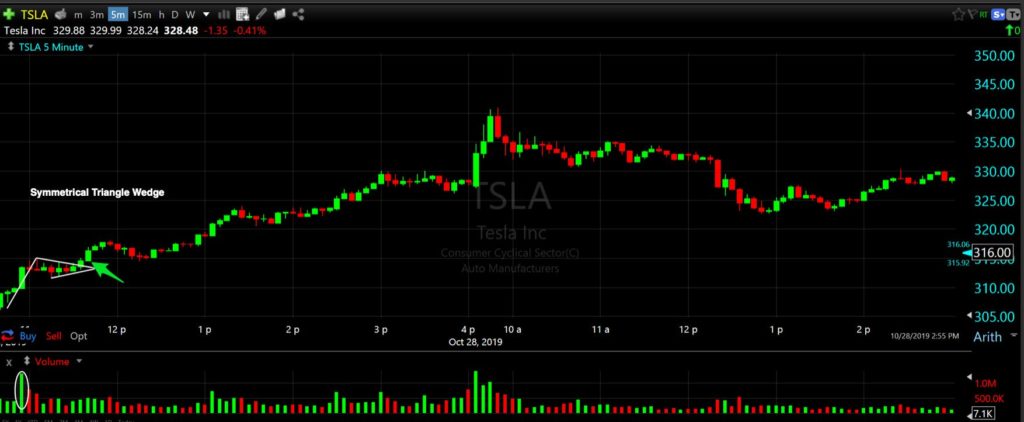The bull flag pattern is a continuation formation found in an uptrend of a stock or asset. The shape of the flag is not as important as the underlying psychology behind it.
There are countless trading patterns out there that you can find in any basic Technical Analysis book, but today we will go through one very prominent and well-known pattern, the Bull Flag.
As the name implies “Bull”, referring to this pattern as a bullish setup, meaning one believes this pattern should lead to a move higher.
What is a Bull Flag Pattern?
The Bull Flag is well-known and prominent pattern for day traders, swing traders, and investors alike.
The first cornerstone of this setup is to have price move up strongly, preferably with an increased amount of volume, signaling increased and more aggressive buying pressure. This is what forms the pole portion of the Bull Flag.
Next, you want to see the price consolidate in some form of a wedge pattern. This can be portrayed in a few ways as you will see below (the green arrow indicates the buy point on the flag-line break, and the stop/risk level is represented by the bottom white line):
Descending Wedge
Ascending Wedge

Symmetrical Wedge
Features of a Bull Flag Pattern
- Stock consolidates near the top of a flag formation on lighter volume, signaling continuation towards higher prices.
- Stock makes a large move up on high relative volume that forms into two parallel trend lines.
- The stock has broken out of the consolidation pattern with high relative volume, meaning that this trend is likely to continue.
Bull flags are a subset of our momentum trading strategy and can be used on any time frame. We like to trade them because we believe they work well as short-term price movements that allow us to scalp the market for quick profits.
They work just as good on daily charts too, making these types of patterns great tools for swing traders who wish not only enter trades but also exit very quickly in order to lock in those gains before moving onto another opportunity with high potential return rates.
Essentially, you want to see price being squeezed in a tighter range in one of these types of wedge formations and then wait for the break upwards of the flag.
The break of the flag should preferably be accompanied by an increase of volume to aide in confirmation of continued momentum. At its core, this is the Bull Flag.
Bull Flag Strategies
Many strategists argue that it is best to buy at the lower end of a trend. However, this means you are risking your trade in case there is new bearish movement. Buying on an upper side instead indicates bulls control which makes more profitable trades for traders looking to profit from uptrends rather than downtrends.
When using the bullish flag, another popular strategy is to use a buy stop order. In this case, you should place a buy stop slightly above the upper side of the flag at price level X where there will be an assumption that if there is indeed a breakout then your new position would become as such and therefore it becomes more advantageous because why not put in some extra money for security?
Bull Flag Vs. Bullish Pennant
A bull flag and a bullish pennant look nearly identical, but there is one small difference between them. A bullish pennant forms in the shape of triangle instead of just support-resistance patterns like that found in a bull flag. The important levels to watch for when trading this pattern are on the upper side above resistance or below support depending on which side you enter at according to your chosen strategy.
This can be compared with an ordinary breakout from consolidation where either level may act as critical points before taking off higher or lower respectively so it pays to get familiarized with both types if possible!
Bull Flag Vs. Bear Flag
A bear flag and a bull flag are the same chart pattern, just mirrored. A bear's flag appears in a downtrend as opposed to the bull which occurs during an uptrend.
Both patterns will breakout from consolidation once price breaks out of either channel line or base respectively; however, projections can be made using the length of each pole (bull/bear) for greater accuracy.
Pros of Using Bull Flag
It's a very common pattern, so you're bound to see them in action on any given trading day.
A bullish flag pattern is highly accurate and easy to identify.
Good for day traders, swing traders, or long term investors - It forms on all chart time frames from a 1-minute chart up to as high as weekly or yearly charts for longer term trading.
Cons of Using Bull Flag
There are a few downsides of using the bullish flag pattern. It can take days or months for this pattern to form on a longer term chart.
If you are not careful you could get fooled by false breakouts when trading with this strategy. We have a few pieces of criteria we use in our live trading group to help identify and avoid "false breakouts" in patterns like this.
Trade Management
A lot of trading success comes from finding styles and patterns of trading that gels well with you are as an individual and trader.
Along with this comes different trade management perspectives. Once you understand this pattern from a visual perspective, execution in real time becomes the most important task.
How will you enter this trade? Some will buy the point of the flag break, some ahead of the flag break, some well after its broken out and on pull-backs and replacements.
I personally prefer to buy the flag line break and risk off the base support level.
Taking Profits
At what prices will you take profits? Will you scale out? Will you hold it all for some target you’ve deemed reasonable and valid? Are you going to use a trailing method?
Define your exit system ahead of time so you don’t have to think on the fly how you’re going to manage trades. We use a trailing method at LiveStream Trading which takes out the guesswork and emotion of the trade by having defined stop loss and profit targets ahead of time, and finally trailing the last portion of our shares as long as the time frame we are trading is still in trend.
There really isn’t a correct answer or one size fits all when it comes to your exit approach. Some may exit once the trade reaches 3R+ (three times risk), or until a trend break. It comes down to what works best for you and what you’ve proven works in your own data and results.
The best way to track your data is by using a free trading journal and collect data on every trade you take. Check out this blog post on aggregating your data and turning it into a trading system.
Stopping Out
There are no trade setups that work 100% of the time, so its important to properly manage risk and know where to exit if the trade doesn't work in your favor.
At what point will you accept your thesis is wrong? Depending on your entry type, you may vary where you place your stops.
For some traders their stops will be at the low of the past few candles, or at the low of the flag as a whole, some will even use arbitrary number stops to give wiggle room to their trades, but I personally disagree with that method.
I'm a firm believer in having one entry point with a defined risk level (stop loss) determined ahead of time and 4 targets that I use to exit the trade on for profit.
If a setup meets all the 4 points of criteria that I use to validate a trade that's going to offer me an 80%+ win rate, I will take one entry (on the trigger of the flag break), and have a set stop on the base/support level.
Defining Your Trading System
No basic trading pattern or setup is not going to turn your trading from rags to riches. Knowing the visuals to the pattern is a start, but its not going to be enough to find consistent profitability.
I promise that there is no simple pattern that is going to make you a successful trader unless you have done the due diligence to back-test and add specific criteria to the pattern that must be met.
For example, our trading system requires at least 4 points of criteria to be met before we can validate a trade. The pattern itself is just one piece of criteria, and then there are 3 other things that need to be met that will make a setup go from a 50% win rate to an 80% win rate.
I found this out though vigorous back-testing and years of experience, however, you can learn our trading system and skip all of those hard steps and learn what works right away.
To be consistently profitable trader you must have hard rules and criteria to follow which will validate every setup you trade.
To give you some insight on what these types of criteria could possibly entail is indicators, time of day and volume requirements to name a few.
At Livestream Trading we provide all of our students with an edge to trading the markets that I’ve vetted with for over 13 years of trading experience.
Everything from defined chart patterns and setups to all the gritty details that make them work with a high win rate.
Hope you found this post helpful, stay tuned for our next blog post on short selling setups!
Get Started with a Free Day Trading Video Lesson Below!

Learn How To Day Trade Stocks







